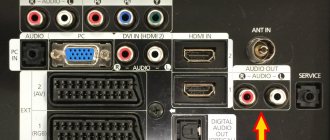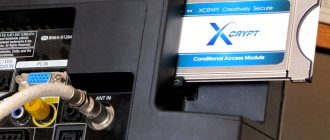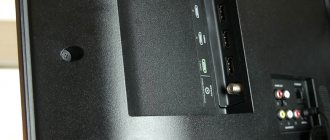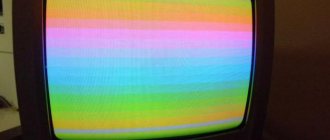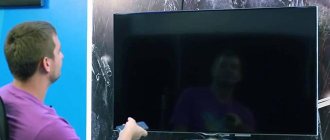A TV with a built-in satellite receiver has some advantages.
History Corner!
Yes, that’s what I wrote in 2013! In a word, a few lyrical memories, or what we worked with not so long ago.
- No need for a separate receiver.
- No need for HDMI-HDMI connecting cord
- No need for a separate remote control.
But, you can forget about Aunt “sharu”, which is not a disadvantage for owners of official access cards.
But if the TV has a built-in digital tuner that supports the DVB-S2 standard, this means that the TV will receive (if the antenna is correctly tuned to the satellite) the signal of satellite channels.
TV with built-in satellite receiver, however, be careful:
This is where confusion can sometimes occur, because other tuners with similar names are built into the panels and have nothing to do with satellite TV.
So:
— The tuner for terrestrial digital broadcasting is called DVB-T2 or DVB-T (not suitable) — The tuner for cable digital broadcasting is called DVB-C (not suitable) — The tuner for satellite digital broadcasting is called DVB-S2 or DVB-S (Suitable)
The letter T stands for terrestrial TV, the letter C for cable, and the S for satellite. As you can see, the difference is only in one letter, and the tuners are completely different.
Installation of antenna equipment does not differ from standard installation using an external receiver.
TVs with a built-in satellite receiver can easily scan channels both manually and automatically, but will only show unencrypted channels.
Almost all modern TVs with a built-in satellite tuner support the DiSEqC 1.0 protocol, which means you can receive signals from at least four satellites using a 4x1 DiSEqC switch.
One... just a satellite receiver and antenna built into the TV will not be enough.
The fact is that almost all television channels broadcast from satellites are not broadcast in an open format, but in one encoding or another.
"AS PLUS" - in Crypt On, Tricolor TV - in DRE Crypt, "NTV +" and many erotic operators - in Viaccess, "Raduga TV" and "Continent TV" - in Irdeto, "Telekarta" - in Conax and etc.
And therefore, having installed an antenna and tuned in the channels of one or another operator on your TV, on the screen, instead of the long-awaited high-quality image and favorite program, you will only see an inscription something like “Coded channel”.
To solve this problem, you need to purchase and install a decoding device in your satellite TV - the so-called access module (CAM module and access card inserted into the CI+ slot)
Do you mean that 90% of satellite TV channels are encoded!
And so... TV with built-in satellite receiver
NTV+ conditional access module Viaccess CI+ for setting up NTV-Plus channels on DVB-S2 TVs of various brands.
Let's start with Samsung, for example:
First, it is advisable to reset the TV to factory settings:
Menu > support > self diagnostic > reset > ok.
After the reboot, go to menu > channel > antenna > select the “satellite” value.
Further in the same section: satellite. system - enter the password > 0000
We uncheck all satellites that are installed by default (if this fails, you need to remove the CAM module from the slot and reset the TV again).
We scroll through and select the EutelsatW4 36E satellite, in the LNB settings we select transponder 12130 R, lower gene. LNB - 0, top - 10750.
Then we go to “manual settings”, look for the 12130 R transponder, turn on “network search” and click “search”. We wait for the search for NTV-Plus channels to complete and save the found channels.
You can then sort the channels to your liking with some...Channel List Editor
If the EutelsatW4 36E satellite is not in the settings, do this:
Select “User sat 1”.
We create our satellite (put a bird in front of it) and save it.
References
- Temporary guidelines. Prevention, diagnosis and treatment of new coronavirus infection (COVID-19). Version 10. 02/08/2021.
- Lize M. Grobbelaar et al. SARS-CoV-2 spike protein S1 induces fibrin(ogen) resistant to fibrinolysis: Implications for microclot formation in COVID-19/ medRxiv, 2021.
- Elizabeth M. Rhea et al. The S1 protein of SARS-CoV-2 crosses the blood-brain barrier in mice/ Nature Neuroscience, 2021, Vol. 24, pp. 368–378.
- Andrey V. Letarov et al. Free SARSCoV2 Spike Protein S1 Particles May Play a Role in the Pathogenesis of COVID19 Infection/ Biochemistry (Moscow), 2021, Vol. 86, No. 3, pp. 257–261.
- https://www.rospotrebnadzor.ru/about/info/news/news_details.php?ELEMENT_ID=15649
- https://sputnikvaccine.com/rus/
- Materials from the test system manufacturer.
Development history
Sputnik Light, like Sputnik V, was developed by the Gamaleya National Research Center for Epidemiology and Microbiology.
Phase I/II clinical studies took place from December 5, 2020 to April 15, 2021. According to the developers, the effectiveness of the vaccine 28 days after immunization was estimated at 79.6%. They claim that Sputnik Light is 80% more effective than many other vaccinations that require two doses.
On May 6, 2021, Minister of Health Mikhail Murashko officially announced the registration of Sputnik Light, the fourth Russian vaccine against coronavirus.
How to use
The television antenna must be connected to a special connector of the existing equipment. Then they begin the setup process in the “Channels” tab in automatic mode. The signal source must be “Satellite”, after which the setup process continues.
Be sure to choose a satellite and set up the display. It is recommended to click on “Change satellite settings” and find the available channels. After that, click “Next” to search for programs installed on the equipment used.
Reference! In the window that appears, a window with various settings will be available. It is recommended to check the quality of the signal used and the displayed image. This determines how correctly the antenna is configured to receive satellite channels.
At the next stage, search parameters are determined. If the CAM module is missing, select the “Skip encrypted channels” option, because they are not available for broadcasting. To search, click “Run”.
After the channels have been found, you can sort the programs and make additional settings for high-quality image and sound. After this, you can fully enjoy watching television.
Differences between DVB-S2 and S-standard
The DVB-S, DVB-S2 standards imply the use of special keys for broadcasting modern satellite television. They transmit TV signals in compressed form to the receiver. Satellites transmit signals in the centimeter frequency range. The highest density of TV channels is in the KU band, frequency band 10.7 to 12.75 GHz. The DVB-S2 standard makes it possible to broadcast a signal 30% faster, but its digital codes cannot be decrypted by a DVB-S receiver.
The DVB-S2 tuner is designed to receive standard and HD quality TV channels. This tuner can be configured to connect to the Internet.
What the DVB-S2 standard is capable of
Any broadcast program that is transmitted via satellite to the receiver is suitable for this standard. This standard differs from its predecessor in that it is capable of:
- Firstly. support both standard SDTV and HDTV programs in high definition.
- Secondly, used to connect to the Internet;
- Third, provide access to vocational programs;
- Fourthly, ensure the connection of any devices to the Network for the purpose of distributing content.
The modernization of the DVB-S standard to the DVB-S2 standard was carried out to improve the quality and speed of digital information transmission. For example, without a receiver with the DVB-S2 standard, the broadcast frequencies of HDTV channels will not be available.
You can install the DVB-S2 standard and connect to digital broadcasting today. This connection option makes it possible to receive the selected package of TV channels from a satellite. A receiver of this standard is a universal device that can be used to connect a TV to digital television, and to connect any gadget to the Internet.
The HDTV frequency decoding function is available in most TV models today. A DVB-S2 receiver allows you to better use their capabilities. Otherwise, why would you buy a TV with a large plasma screen when every program looks exactly the same on a regular screen? Reception and the ability to decode high-definition frequencies on a TV is a very useful function, but this requires an HDTV signal source. The keys in it are provided by the DVB-S2 standard.
How to use
The television antenna must be connected to a special connector of the existing equipment. Then they begin the setup process in the “Channels” tab in automatic mode. The signal source must be “Satellite”, after which the setup process continues.
Be sure to choose a satellite and set up the display. It is recommended to click on “Change satellite settings” and find the available channels. After that, click “Next” to search for programs installed on the equipment used.
Reference! In the window that appears, a window with various settings will be available. It is recommended to check the quality of the signal used and the displayed image. This determines how correctly the antenna is configured to receive satellite channels.
At the next stage, search parameters are determined. If the CAM module is missing, select the “Skip encrypted channels” option, because they are not available for broadcasting. To search, click “Run”.
Connection via receiver
The TV signal goes to the TV antenna and then to the receiver. This device converts the signal format.
Digital broadcasting is decoded by the receiver, then its signals are translated into:
- Analog signals. Output from the receiver to the TV via SCART or RCA .
- Digital signals for output via HDMI interface.
Signals from the receiver to the TV are supplied via a TV cable.
Types of connectors for connecting via television cable to a TV:
- HDMI _ The signal output method via the HDMI interface is the most convenient and modern. passing through HDMI does not need to be re-encoded to analog. HDMI carries high definition television signals. This means the ability to enjoy the highest quality video resolutions and multi-channel audio transmission. The device is also equipped with built-in data protection against copying. An HDMI antenna can be connected to a laptop to watch TV channels from it.
What is lnb satellite in on TV
The firmware of the receivers used initially includes special keys that allow you to view television channels that are under special encoding. The TV does not have keys. It is impossible to enter key combinations or change the firmware.
Important! To watch TV using modern DVB-S2 technology, special CAM modules are used, into which cards from operators are inserted. The module is then inserted into a special PCMCIA connector. In this case, the satellite antenna must be connected to the LNB Satellite IN connector.
What is lnb satellite in on TV
The firmware of the receivers used initially includes special keys that allow you to view television channels that are under special encoding. The TV does not have keys. It is impossible to enter key combinations or change the firmware.
Important! To watch TV using modern DVB-S2 technology, special CAM modules are used, into which cards from operators are inserted. The module is then inserted into a special PCMCIA connector. In this case, the satellite antenna must be connected to the LNB Satellite IN connector.

